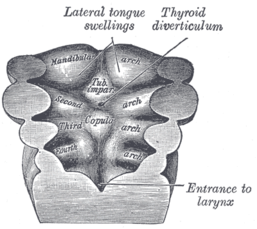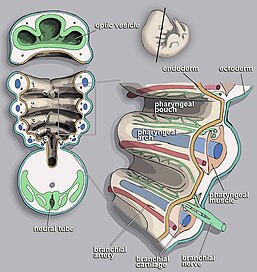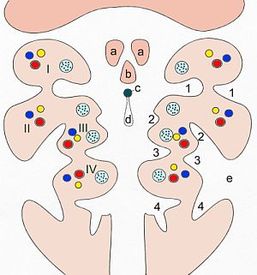| Pharyngeal arch | |
|---|---|
 Schematic of developing pharyngeal arches and pouches in the human embryo at seried Carnegie stages (CS) | |
| Details | |
| Carnegie stage | 11–14 |
| Identifiers | |
| Latin | arcus pharyngei |
| MeSH | D001934 |
| TE | arch_by_E5.4.2.0.0.0.2 E5.4.2.0.0.0.2 |
| Anatomical terminology | |
Scheme of the pharyngeal arches
- I–IV: pharyngeal arches
- 1–4: pharyngeal pouches (inside) and/or pharyngeal grooves (outside)
- a: Tuberculum laterale
- b: Tuberculum impar
- c: Foramen cecum
- d: Ductus thyreoglossus
- e: Sinus cervicalis
The pharyngeal arches, also known as visceral arches, are transient structures seen in the embryonic development of humans and other vertebrates, that are recognisable precursors for many structures.[1] In fish, the arches support the gills and are known as the branchial arches, or gill arches.
In the human embryo, the arches are first seen during the fourth week of development. They appear as a series of outpouchings of mesoderm on both sides of the developing pharynx. The vasculature of the pharyngeal arches are the aortic arches that arise from the aortic sac.
- ^ Zbasnik, N; Fish, JL (2023). "Fgf8 regulates first pharyngeal arch segmentation through pouch-cleft interactions". Frontiers in Cell and Developmental Biology. 11: 1186526. doi:10.3389/fcell.2023.1186526. PMC 10242020. PMID 37287454.


